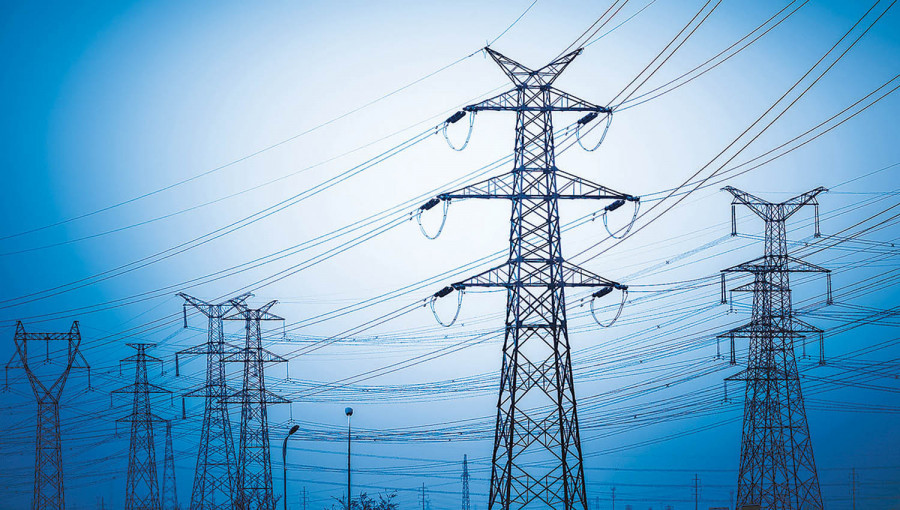National
Nepal to seek end to Indian regulatory restrictions on electricity exports at bilateral meeting this week
The meetings of the joint secretary-level Joint Working Group and the secretary-level Joint Steering Committee will be held in Jaipur on February 17-18.
Prithvi Man Shrestha
Nepal will seek an end to Indian regulatory restrictions on seamless trade of power between Nepal and India in the upcoming bilateral meetings on energy later this week.
The meetings of the joint secretary-level Joint Working Group and the secretary-level Joint Steering Committee are scheduled to be held in Jaipur, India on February 17-18 and the Nepali delegation is set to leave for India on Thursday.
Officials at the Energy Ministry said they have finalized the agenda for the meetings.
One request that Nepal will make to the southern neighbour, according to officials, is a long-term approval for Nepali hydropower projects to sell electricity in the Indian market.
Currently, Nepal has been allowed to sell 452.6MW of electricity generated by 10 hydropower projects in the Indian power market. “But the approvals given to the 10 hydropower projects need to be renewed every year,” said Madhu Bhetuwal, spokesperson of the Ministry of Energy, Water Resources and Irrigation. “That’s why we will propose with the Indian authorities that such approvals be given for at least five years.”
Nepal had raised the issue when Indian Foreign Secretary Vinay Mohan Kwatra met with Deputy Prime Minister and Energy Minister Rajendra Lingden on Tuesday.
“We asked the Indian foreign secretary to either end the provision of renewal or give long-term approval, of at least five years,” said Energy Secretary Dinesh Ghimire, who is leading the Nepali delegation during the energy talks in India.
Nepali officials say the provision of annual renewal has invited administrative hassles and caused hindrance in ensuring seamless trade of power. In early November 2021, India had for the first time allowed Nepal to sell electricity in the Indian market via a competitive bidding process.
Initially, the southern neighbour had permitted Nepal to sell 39MW generated by the 15MW Trishuli and 24MW Trishuli hydropower projects. Since June last year, power generated from more power projects was also allowed to be sold in the Indian market.
During the meetings, Nepal will also ask India to provide Nepali power exports similar tax benefits as Indian hydropower projects.
In a move that will make hydroelectricity generated by Indian projects cheaper than that produced by Nepal, India’s power ministry removed the inter-state transmission charges for new Indian hydropower projects starting early December last year.
The ministry on December 2 issued the order to waive Inter-State Transmission System (ISTS) charges on the transmission of electricity generated by new hydropower projects. The waiver is already available to solar and wind power projects.
The move has, however, raised the hackles of Nepali officials and the private sector as this concession will not be applicable to the hydroelectricity exported by Nepal and result in Nepali power producers losing a competitive edge in the Indian power market.
Bhetuwal said Nepal would seek equal treatment for hydropower exported from Nepal as Nepal’s power would also be helping India’s renewable push.
According to him, Nepal will also ask India to remove the restrictive clauses in bilateral power trade in the Procedure for approval and facilitating Import/Export (Cross Border) of Electricity) by the Designated Authority which was issued by the Indian government in February 2021.
The procedure introduced a clause, 6.3(i), that prohibits trade with power plants that have ownership from any country that shares “a land border” with India but doesn’t have a bilateral power agreement on power sector cooperation with India—indicating China and Pakistan.
Nepal initially thought the restriction would apply only to projects with Chinese investment. But the southern neighbour has been reluctant to engage in power trade even with those projects that involved Chinese construction contractors, officials said.
Nepal failed to get approval from the Indian authority to sell power generated from the 456MW Upper Tamakoshi Hydropower Project in the Indian market because a Chinese contractor was involved in the civil works of the project. The project was developed using Nepal government’s own money.
“We will try to convince the Indian side to make the provision more liberal so that seamless power trade could be achieved as envisioned in the Joint Vision Statement on Power Sector issued by Nepal and India in April 2022,” said Bhetuwal, while declining to talk on the specifics.
The issue was, however, not raised at the meeting between Kwatra and Lingden, according to Secretary Ghimire.
Managing Director of Nepal Electricity Authority Kul Man Ghising expressed his frustration with the Indian policy in a public forum in December last year.
“We have noted India’s concerns regarding Chinese investment or ownership in our power projects, but how can we bar contractors selected through global bidding?” asked Kul Man Ghising, speaking at a World Bank conference on South Asia in December last year, according to a report in India’s The Hindu newspaper. “In hydro-power civil construction, there are very few Indian or European contractors that can compete on cost,” he explained, adding that a single contractor should not be the reason to hold back regional trade.
According to Bhetuwal, Nepal will also propose a long-term power purchase agreement (PPA) between the companies of the two countries. Nepal buys power from the Indian market and sells there in the day-ahead market which is dependent on volatile prices.
“A long-term PPA ensures predictability in prices which will help increase more investment in Nepal’s power sector,” said Bhetuwal.
According to him, the two sides will also discuss developing two more high-capacity transmission lines.
Bhetuwal told the Post on Tuesday that the two sides would discuss developing the proposed 400kV transmission line connecting Inaruwa (Duhabi) of Nepal and Purnia of Bihar, India and 400kV New Lamki (Dodhara)-Bareli Cross Border Transmission.
“Talks will be held on the construction modality of these two new power lines,” he said. “We want these projects to be completed by 2027.”
As hydropower production has been growing in the country amid limited consumption, Nepal must sell more power to India to avoid spillage. For that, reliable infrastructure for cross-border transmission of power is necessary, officials say. Nepal has a dozen cross-border transmission lines under operation currently.
Only the Dhalkebar-Muzaffarpur Cross Border Transmission Line has 400kV capacity, which can transport around 1,000MW. Other 11 cross-border transmission lines can transport between 5MW and 125MW only, according to a white paper on energy issued by the ministry in May 2018.
“There will be a discussion also on upgrading the existing low capacity cross border power lines,” said Bhetuwal.
Bhetuwal said Nepal would also seek India’s facilitation to enable Nepal to export power to Bangladesh.
Nepal and Bangladesh in August last year had decided to request the southern neighbour to allow the export of 40-50MW of electricity from Nepal to Bangladesh in the initial phase by utilising the high-voltage Baharampur-Bheramara cross-border power transmission link. The NEA said it sent a request to India’s NTPC Vidyut Vyapar Nigam twice on the matter.
“Without India’s support, we cannot export power to Bangladesh because we have to use Indian transition infrastructure,” said Bhetuwal.




 14.12°C Kathmandu
14.12°C Kathmandu




%20(1).jpg&w=200&height=120)








%20(1).jpg&w=300&height=200)

